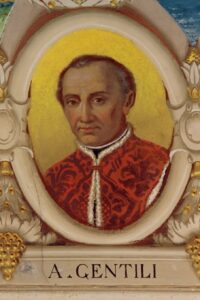Alberico Gentili, in latin: Albertus the Gentile, is the most famous character of the village; great jurist, he is still the only Italian to have held the title of Regius professor of civil law at the University of Oxford and is considered, together with other illustrious exponents, one of the founding fathers of international law.
1. Aristide Morichelli-d'Altemps
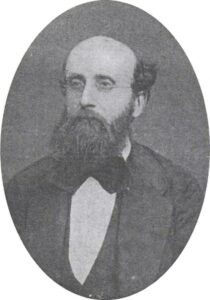
Who was: Noble and politician
Vita: San Ginesio, 15 April 1826 – San Ginesio, 6 January 1896
Description: Aristide Morichelli d'Altemps was born in San Ginesio on 15 April 1826 to his father Ilarione Morichelli and Marianna d'Altemps. Belonging to the noble family Morichelli-d'Altemps, born by marriage of the two parents, both of noble family, during his life he will cover a short military service as a second lieutenant of the Second Civic Company of the San Ginesio Battalion. Already at 25 years his name is on the list of 96 richest people in the municipal area e, because of his political ideas, close to the thought of StHistorical window, of’anarchy and gods revolutionary movements, he was placed under surveillance by the local authorities. After graduating in law, on 17 September 1851 was elected city councilor, even if the apostolic delegate of Macerata did not validate the vote, considering it null for political reasons. After being re-elected on 3 September 1857, on 10 November of the same year was chosen to become Prior, the equivalent of the mayor, position to be filled from 1858 to 1860.
Assumed the office on 26 January 1858, and automatically became leader of the judiciary of San Ginesio, with the events that led to the Castelfidardo Battle on 18 September 1860 and the weakening of the Papal States, was chosen as president of the Provisional Council of City Government and member of the provincial, position to be filled from 24 September 1860 to 10 February 1961. With the birth of the Kingdom of Italy, on October 1860 he became the first mayor of San Ginesio, although his work, rich in internal feuds, it wasn't simple. Forced to leave office in the 1868 for family reasons, was re-elected again in August 1882, holding again the title of mayor until 1891.
2. Raffaele Merelli
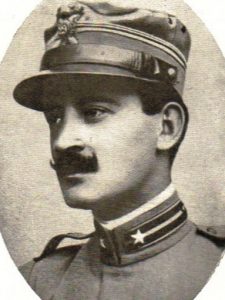
Who was: Teacher and military
Vita: San Ginesio, 19 August 1886 - Please, 10 October 1916
Description: Raffaele Merelli was born in San Ginesio on 19 August 1886 by Agostino Merelli and Clotilde Onofri. After completing master's secondary studies, presumably to schools in their own country (today IIS Alberico Gentili) took up the profession of teacher at the elementary schools of Monza, specializing in scientific studies and also attending an electrical engineering course. Supporter of interventionism in the WWI, after the Kingdom of Italy entered the war, occurred on 24 May 1915, he enlisted in the Royal Army, precisely in the 29th Infantry Regiment, "Pisa" brigade, with the rank of second lieutenant of the M.T..
In December of the same year he reached Sacred, on the Isonzo front, finding himself fighting against the Austrians in the fourth battle of the Isonzo: it was on this occasion that his ingenuity led him to the creation of a special device for launching jelly tubes designed to destroy enemy fences, thus saving the lives of many of his fellow soldiers. In the early months of 1916 fu promoted to lieutenant and took part in all the fighting sustained by his brigade, employed by the 21st division. In San Martino del Carso, or in the quinta battaglia, deserved a solemn commendation on 6 June and the 6 August, during the preparatory phase of the sixth battle, was wounded during an assault on a trench, this earned him the bronze medal for military valor. After recovering from health, during the eighth battle, precisely the 10 October, participated in an attack on Lokvica during which he came out of the Italian trenches to go and check the damage inflicted on the fences that protected the enemy positions, and then attacking them at the command of his platoon. During a hand-to-hand combat inside an opposing trench it was wound a first time, continuous the continuation of all the necessary requirements fight until he received a shotgun shot abdomen, immediately pouring in serious condition. He died the next morning inside a surgical ambulance of the 3rd Army in Gradisca. For his courage he was decorated with the medal of gold to military valor.
To date Merelli has received other awards: Macerata and San Ginesio have a street that bears his name, Rome has dedicated a school to him and Monza, as well as dedicating a way to him, he placed a commemorative plaque on the outer wall of the school where he taught.
3. Giovanni Cucchiari
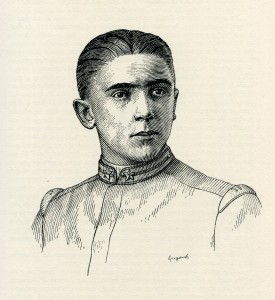
Who was: Militare
Vita: San Ginesio, 26 November 1894 - Mount Podgora, 24 June 1915
Description: Giovanni Cucchiari was born in a building along via Capocastello by Giuseppe Cucchiari and Augusta Mazzolini il 26 November 1894. Descendant of the Mazzolini family and of general Domenico Cucchiari, he studied at the Academy of Fine Arts in Ravenna, until he left his studies, almost done, to enlist in the Royal Army in August of 1914. Once he entered, he was included in the 11th "Casale" infantry regiment, from which he passed as a draftsman to the Fortifications Office of Udine. When Italy declared war onAustria-Hungary on 24 May 1915, he joined his regiment at the foot of the hills between Oslavia and Mount Podgora. On 23 June, day of the first battle of the Isonzo, his brigade was placed in the front row but, hampered by the fences and given that the Italian army lacked the appropriate means to deal with them, they sent men with wire cutters and jelly-laden tubes.
Offered voluntarily, Cucchiari joined a patrol that the 24 June, in broad daylight, he tried to open a passage in the thick of the enemy fences, but leaning out of the trenches he was hit by numerous enemy rifle shots, dying instantly during the fight. This action earned him the gold medal for military valor.
To date Cucchiari has received other awards: San Ginesio dedicated the name of a street to him and placed a commemorative slab on the native palace. Roma, instead, dedicated a plate to the M.O.V.M. which shows the motivation of his gold medal.
4. Guglielmo Ciarlantini
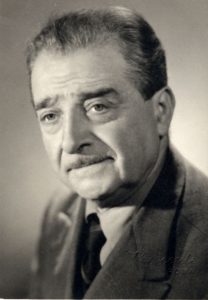
Who was: Painter, teacher and architect
Vita: San Ginesio, 21 November 1881 – San Ginesio, 1959
Description: Guglielmo Ciarlantini was born in San Ginesio on 21 November 1881 by Elimeno Ciarlantini and Domenica Ricci. His business like painter began before taking regular art courses. The turning point in his life came from Brother Paolo Mussini that, after having surprised him painting the apse of the Church of Santa Maria delle Grazie in the Convent of the Clarisse, advised him to enroll in the Academy of Fine Arts in Rome. In 1905 he moved to the capital where he enrolled in the nude course at the Institute of Fine Arts, meanwhile he attended the history of art lessons given by Giulio Ferrari at the Art Museum of Rome and attended the studio of Giulio Aristide Sartorio. To further expand the knowledge of the art sector, for two years he attended the French Academy at Villa Medici.
After completing his studies he returned to San Ginesio where he taught three years in Directed by Scuola Normale (today IIS Alberico Gentili) as alternate member, but due to the entry of the Kingdom of Italy in the First World War, he was called to arms. After the war he returned to the Marche where he continued his career as a teacher for about thirty years at the Art Institute of Macerata. In 1939 he was appointed commissioner for state exams in the commission of Ascoli Piceno and became part of juries for artistic competitions, the last of which was announced for the decoration of the concert hall of the Liceo Rossigni in Pesaro, as well as being Honorary Inspector of Antiquities, Monuments and art galleries for over thirty years. In 1951 he was appointed Ordinary Academician of the Accademia dei Catenati of Macerata, only to die in his hometown in 1959.
Ciarlantini did not only deal with painting, but also of architecture, built under the Fascist period. Most of the works are in rationalism Italian, but due to anti-fascism many have been lost or changed. but due to anti-fascism many have been lost or changed, while remaining fascinated by the Pre-Raphaelite style.
Other works by Guglielmo Ciarlantini are in Sant’Angelo in Pontano, San Giovanni pen, They Piceno, Gualdo, Belforte del Chienti, Tolentino, They reign of Tolentino, San Severino Marche, changing room, Macerata, Corridonia, Francavilla d’Ete Fano, Pesaro, Casal Monferrato and Turin. Numerous portraits of private clients are scattered around. We have certain and documented news of the portrait of Sir Thomas E. Holland and Madame Holland in London and some portraits made in the Roman period.
5. Febo Allevi
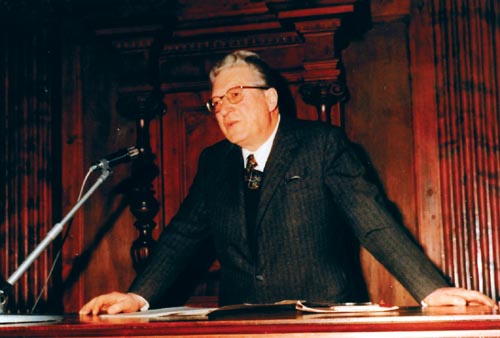
Who was: Essayist and historian of literature
Vita: San Ginesio, 11 January 1911 - Macerata, 11 April 1998
Description: Of irregular cultural formation, essentially self-taught, interrupted his studies in 1922, he took them back a decade later, becoming in the 1942 owner of Italian letters, Latin and history in the Magistral Institutes. Mayor of San Ginesio since June 1956 to November 1960, he dedicated to school and to literary and historical research, his entire existence, arriving at the presidency of the Liceo-Ginnasio “G. Leopardi” of Macerata and teaching History of Popular Traditions and History of Literary Criticism in the Faculty of Letters and Philosophy of the local University.
Passionate and diligent scholar of the Middle Ages, he was also an attentive and authoritative critic of Foscolo, Parini, Monti, of the romantic age, of local history and literature. A large range of cultural interests cultivated with extreme passion, with methodological rigor and with always renewed enthusiasm.
Among his many contributions to historical and literary studies, a volume, in particular, it emblematically summarizes the liveliness and extension of the author's cultural interests: Literature and History, (Napoli, G. Greco 1992). The book, packed and locked six hundred pages (it includes contributions very far in the years), despite an apparent heterogeneity of contents (it goes from Laurentian rhythm to Middle Ages by Umberto Eco), they are wide-ranging; on the other hand, all of Allevi's writings enjoy a cultural and scientific depth that is hardly questionable if his literary or historical criticism has included the method, the theoretical figure that drives it has been discovered, it has been carefully assessed in working practices that do not neglect any aspect, even marginal, research. And that method, In short, it can be traced back to the documentary need that supports and solidifies the critique of ideas which allow a value judgment without convenient covers, without sagging and camouflage.
Historical or literary, this criticism that comes from afar, from the critique of the ideas of the romantics, from the erudition of the positivists, from the never forgotten lesson of Crociana, is critical of involve, if you want, of to compromise, certain of the total commitment of the critic who claims freedom and autonomy of intellect and conscience, a commodity now rare in today's cultural landscape. A broad argument follows, devoid of the distress of contemporary specialists, enriched and comforted by a cultural ease that reads and interprets documents and facts and apparently distant things, disparate; argument supported by the guiding idea, corroborated by the massive intervention of meticulous bibliographic references, precious, sometimes intrusive and preponderant; the result of many readings: historians and theorists of history, men of letters and literary theorists, artists and art theorists, the small and large, the least and the greatest of erudition and criticism. No page, in the many writings of Febo Allevi, is an exception to this methodological framework which seals the scientific value of the research.
To literature, and to some of his poets in particular, Allevi devoted serious and passionate studies.
Already in 1948 a monographic work, Ugo Foscolo (C.F.L.I.), revealed a particular predilection for authors and works of the romantic area; In the 1955, for New Italy, public Vincenzo Monti, a book in which one advances reading certainly innovative by the poet of Alfonsine, officially far from the romantic fire, “but not insensitive to the jolts of the European soul”. And the Monti delle Lessons from Pavia, will open five years later, the lucky volume Texts of romantic poetics (Marzorati).
In 1965, in the atmosphere of the celebrations for the seventh centenary of Dante's death, Allevi gives the prints a complex and densely articulated volume, With Dante, the Sibyl and others; from the ancients to the vulgar (Scientific and Literary Editions): vast vast panorama of unexpected issues and problems: culti, legends, pre-Roman Italic myths, the advent of the vulgar, the Carte fiastrensi, the knightly tradition, the Act, the Castra song, the Commedia and the Marca d’Ancona and more.
In 1970 Allevi publishes the very rich volume Fortune and legacy of Parini (Monnier) real rediscovery of the poet from Bosisio.
He will conclude his life as a scholar by dedicating to San Ginesio the last book, Liberty and Belle Époque from a provincial viewpoint (1997). A precious book, exquisite, last homage to his native country, narrated within the great warp of European civilization at sunset. A country, si badi, with the history of an era, not with his chronicle; a story where even the marginal or curious annotation reveals in the author's pen the difference between who tells the facts and who instead, in the narration of the facts, reveals and reaffirms values.
Beyond the scholar, remains the discreet man, reserved and shy. Febo Allevi belongs to that group of eminent Marche people who, with the studio, intelligence, the fruitfulness of one's work, fidelity to the inalienable values of tradition, in every age they have honored and made the Picenian region famous.
6. Nino Patrizi
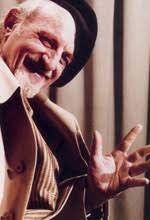
Who was: Sculptor
Vita: San Ginesio, 3 July 1911 – San Ginesio, 1July 1973
Description: Nino (Giovanni) Patricians was born in San Ginesio on 3 July 1911 by Benigno Patrizi and Tullia Silvetti, owners of a cafe on the main square. In 1918 Nino will lose his father due to the Spanish flu, while the mother, after the death of her husband, will remarry. The young man will draw from these sad family events the disturbances and anxieties that will lead him to alcoholism. Gifted with great artistic sensitivity, he was enrolled, with the help of some relatives, at the School of Art of Tolentino directed by Cesare Marcorelli and it was here that he received his first training. In 1929 he moved to Rome where he was able to deepen his studies in various schools, like the Academy of France and the Academy of San Luca. It was precisely in this Academy that Patrizi won an international prize for the "nude from life" but, despite frequenting many leading artists, he did not bond with any group.
The apprenticeship he will carry out at Alceo Dossena will be decisive for giving birth to his style and for shaping his career: will work in Rome from 1929 to 1942, participating in the restoration of the Ara Pacis, in the Vatican, at the Museum of the Baths, at Palazzo Barberini, to the town hall of Sabaudia, in Ancona, to then return to San Ginesio with his wife Clarice Masci, after getting married in 1937. He worked mainly with private commissions, but he enjoyed the friendship of a few admirers, especially of Tolentino, in addition to teaching at the Academy of Fine Arts of Macerata. He died in San Ginesio on 1 July 1973.
